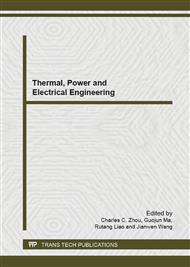[1]
Y.W. Zhang, N.S. Cai, J.B. Yang, B. Xu: Chemosphere Vol. 73 (2008), p.650.
Google Scholar
[2]
Q.X. Cao, S.H. Wu, H. Liu, D.Y. Liu, P.H. Qiu: Chemosphere Vol.76 (2009), p.1976.
Google Scholar
[3]
S.L. Niu, K.H. Han, C.M. Lu: Process Safety and Environmental Protection Vol. 89 (2011), p.121.
Google Scholar
[4]
W.J. Yang , J.H. Zhou, Z.J. Zhou, Z.C. Chen, J.Z. Liu, K.F. Cen: Combustion and Flame Vol.156 (2009), p.1785.
Google Scholar
[5]
S.H. Wu, Q.X. Cao, H. Liu, Q. An, X. Huang: Chinese Journal of Chemical Engineering Vol. 18(2010), p.43.
Google Scholar
[6]
W.C. Li, Z.S. Li, N.H. Cai: Journal of Proceedings of the CSEE Vol. 30 (2010), p.68 (inChinese).
Google Scholar
[7]
X.J. Liang, Z.P. Zhong: Journal of Proceedings of the CSEE, Vol. 29 ( 2009), p.96(in Chinese).
Google Scholar
[8]
F.F. Li, S.H. Wu, Q.X. Cao, et al: Journal of Proceedings of the CSEE, Vol. 28 (2008), p.46(in Chinese).
Google Scholar
[9]
H. Kim, M. Shin, D. Jang: Journal of Applied Thermal Engineering, Vol. 24 (2004), p.2117.
Google Scholar
[10]
Z.H. Wang, Y. Lv, P. He, et al: Journal of Proceedings of the CSEE, Vol. 29 (2009), p.60(in Chinese).
Google Scholar
[11]
Y. Lv, Z.H. Wang, J.H Zhou, et al: Journal of Energy Fuels, Vol. 24 (2010), p.5432.
Google Scholar
[12]
Q.X. Cao, S.H. Wu, H. Liu, et al: Journal of Power Engineering, Vol. 26 (2008), p.349 (in Chinese).
Google Scholar
[13]
Q.X. Cao, Y. Shi, H. Liu et al. In: Numerical Study of Furnace Process of a 600 MW Pulverized Coal Boiler Under Low Load with SNCR Application. 7th International Symposium on Coal Combustion, Harbin, China, 2011.
DOI: 10.1007/978-3-642-30445-3_21
Google Scholar
[14]
Z.M. Lu. In: Study on Reaction Mechanism and Mixing Characteristics of SNCR Technique. Hangzhou: Zhejiang University, 2006(in Chinese).
Google Scholar
[15]
Q.X. Cao. In: Effects of Gaseous Additives for Selective Non-catalytic Reduction of NOx. Harbin: Harbin Institute of Technology, 2009(in Chinese).
Google Scholar
[16]
W.Q. Tao: Numerical Heat Transfer(Xi'an Jiaotong University Press, Xi'an 2001) (in Chinese).
Google Scholar
[17]
B.F. Magnussen. In: On the Structure of Turbulence and a Generalized Eddy Dissipation Concept for Chemical Reaction in Turbulent Flow. 19th AIAA Meeting, St. Louis, 1981.
DOI: 10.2514/6.1981-42
Google Scholar
[18]
R. Rota, D. Antos, E.F. Zanoelo, et al: Journal of Chemical Engineering Science, Vol. 57 (2002), p.27.
Google Scholar
[19]
M. Koebel, E. Strutz: Journal of Industrial and Engineering Chemistry Research, Vol. 42 ( 2003), p.2093.
Google Scholar
[20]
J. Brouwer, M.P. Heap. In: A model for Prediction of Selective Noncatalytic Reduction of Nitrogen Oxides by Ammonia, Urea, and Cyanuric Acid with Mixing Limitations in the Presence of CO, Twenty-sixth Symposium (International) on Combustion/the Combustion Institute, Pittsburgh, Pennsylvania, USA, 1996.
DOI: 10.1016/s0082-0784(96)80036-1
Google Scholar
[21]
H. Zhou, A.D. Jensen, P. Glarborg, et al: Journal of Fuel, Vol. 84 (2005), p.389.
Google Scholar


